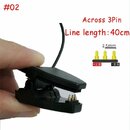victorzamora
Contributor
I think I have one of those that worked with my Ardupilot.....I'll have to search around my box'o'parts tonight. If not, I'll wait for your How-To to buy/build anything.
Welcome to ScubaBoard, the world's largest scuba diving community. Registration is not required to read the forums, but we encourage you to join. Joining has its benefits and enables you to participate in the discussions.
Benefits of registering include
As promised, here's my writeup of what I did to make it work. Hope this helps - any suggestions, errors you find, please let us know. As always, do this at your own risk.
Stuff and things: Oceanic Geo2.0 DIY data cable
I know this thread is pretty old, but is there anyway you still have that write up? The link doesn't work anymore, and I'm having trouble getting it working.
Cheers!

My eBay clip has arrived. The 3 pogo pins are properly spaced, but the cable is not 3 conductor. However, the bottom jaw of the clip is held together by 2 screws, so you can remove the 2 conductor cable and solder the USB-UART cable directly onto the pins. You have to work quickly when soldering, to prevent melting the plastic.. I managed to ruin my first attempt. I had finished the soldering, but the middle joint (ground) looked a bit cold, so I tried to re-solder it and that's when the melting happened. I should have just left it. I held it by the pins in an alligator clip type soldering vise, thinking that this would help to dissipate heat. I also put a small piece of corrugated cardboard between the alligator clip and the upper jaw of the clip, to prevent heating the foam pad on the upper jaw. Since the clip was only $4.08 Canadian, I have ordered another and will get it right in 4 weeks.I may have found the ideal 3 pin connector clip for the DIY cable. I saw this on eBay for $4.08 Canadian shipped and the pin spacing looks perfect. The only thing is that since this is being sold as a smart watch charging cable, I wonder if there are actually 3 wires (conductors) connected to the 3 pins, since only 2 are needed for charging. I may or may not need an interface cable for a TUSA Talis in the future, I'll know in a couple of days and if so, I will buy one of these.The clip that I'm talking about is #2 in this eBay posting: https://www.ebay.ca/itm/Smart-Watch-Magnetic-Charger-Cable-Cord-USB-2-0-Male-to-4Pin-Pogo-Power-Charger/273315981328?var=572670292166
View attachment 526028
Here you go, All credit goes to the OP
I may have found the ideal 3 pin ....
